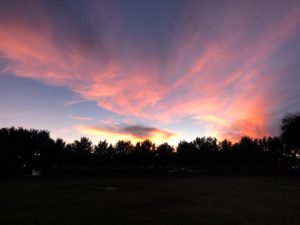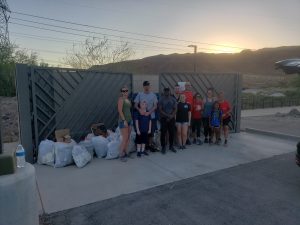Learn About Butterflies Day
Butterflies play essential roles in the environment, no matter where you find them. Our native butterflies here in Nevada in the Spring Mountains are no exception.
In honor of #LearnAboutButterfliesDay, I wanted to write about the butterfly species found in our local mountain range. Katy Gulley, a Wildlife Ecologist for the Spring Mountains National Recreation Area, shared some great information on the subject.
She spoke about the mountain range in general, explaining that all the plants, animals, insects, and other species found in the forest interconnect in complex ecosystems.
Species
Home to over 75 species of butterflies and moths, seven are endemic species. This means they exist in only one geographic area, found nowhere else on Earth.
These species include the Mount Charleston blue butterfly, the Spring Mountains dark blue, the Spring Mountains acastus checkerspot, the Morand’s checkerspot, Spring Mountains icarioides blue, Spring Mountains comma skipper, and the Carole’s silverspot.
The mating season for the butterflies generally occurs during the summer months, from June through September. When it comes to their eggs, they’re present all year round, depending on the species.
Gulley explained that as eggs and caterpillars, they’re very small and difficult to see.
“That’s why it’s important to stay on established trails when you’re visiting the Spring Mountains; to help preserve these habitats,” she said. Depending on the species, the estimated populations for these butterflies vary.
She added that butterflies live at every elevation throughout the mountain range but become more sparse above tree-level. “They typically prefer open areas surrounded by forests,” she said.
Wherever they’re found, the butterflies of the Spring Mountains fit important niches in their habitat.
“They’re pollinators that help disperse pollen for the various plant species that live in the Spring Mountains,” Gulley explained. With the interconnected relationship between all the species and ecosystems of the mountain range, one species’ loss impacts them all.
Endangered – Mount Charleston Blue Butterfly
One of the endemic species in the Spring Mountains, the Mount Charleston blue butterfly, is also the only endangered species in the area.
Listing the butterfly as an endangered species in 2013, this designation awards certain protections. “The US Forest Service works cooperatively with the US Fish and Wildlife Service to protect the species and its habitat,” Gulley said.
The best way to help protect this butterfly involves staying on designated trails to preserve their habitats. Hiking off-trail can result in crushing the eggs or larvae before they even turn into butterflies.
“Also, visitors should leave flowers on plants so they can be food for the pollinators as well as go to seed and then become new plants,” Gulley said. “It’s also important to remember to take pictures from afar so as not to disturb animals and insects.”
(Article continues after the ad)
Please follow our fantastic site sponsors! They make content like this possible! 🙂
Conservation
The protection of the Mount Charleston blue butterfly isn’t the only reason why the Spring Mountains must be protected and respected.
The area is home to seven ecological zones and at least 25 different species of plants, animals, and insects found nowhere else in the world.
“Everything here serves a great purpose and has evolved here as part of this great Spring Mountains ecosystem,” Gulley said.
Protecting their habitats means the continuation of these species and the preservation of these vital ecosystems. Doing so also means that future generations will be able to enjoy these places and wildlife in the future.
Learning About Butterflies and Wildlife in the Spring Mountains
To learn more about the butterflies in the Spring Mountains, check out one of the many established trails to hike.
“There are signs along several trails in the Spring Mountains National Recreation Area that provide information not only about butterflies but also about the plants, animals, and other insects that call this unique place home,” Gulley explained.
In addition, she said that multiple websites and social media groups cover the information surrounding various species, including Nevada Bugs and Butterflies.
She also mentioned that apps, such as iNaturalist, help people learn about, collaborate on, and
identify plants and animals around them. It also helps scientists to track species occurrences.
Overall, Gulley expressed that much of the conservation efforts involve the personal responsibility and mindfulness of those visiting and recreating in the Spring Mountains’ unique environment.
Besides staying on marked trails and only taking pictures – not things, it’s important to always pack out all trash and waste, including dog droppings.
Trash like plastic and cigarette butts, and waste from pets wreak havoc on the environment.
Leaching chemicals and inorganic material into the soil and waterway these materials harm the plants, animals, and insects that call this place home. It’s our job to protect these species and respect their home when we visit.
#GetinMotion for the Butterflies
To take action to protect the Spring Mountains or Nevada public lands in general, start by seeking out volunteer opportunities to help various conservation efforts in the area.
While events are currently on hold for the pandemic, check out Go Mt. Charleston for more information on the mountains in general and to sign up for future volunteer opportunities.
Gulley also recommended checking out partners of the Spring Mountains National Recreation Area. These include the Southern Nevada Conservancy, Friends of Nevada Wilderness, and the Great Basin Institute, just to name a few.
Thank you to our Patreon ‘Cultivator’ supporters who help make content like this possible!
The following Patron(s) supported the production of this article: Crystal Gropp.




Pingback: The Fantastic Forest of the Spring Mountains - Millennials in Motion Magazine